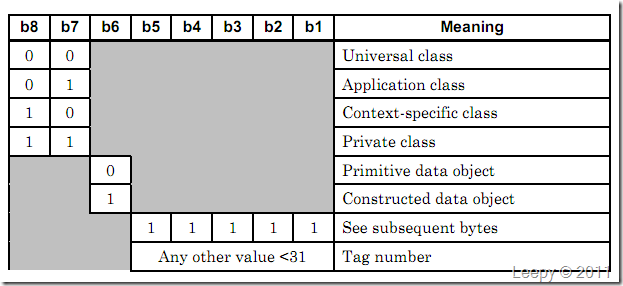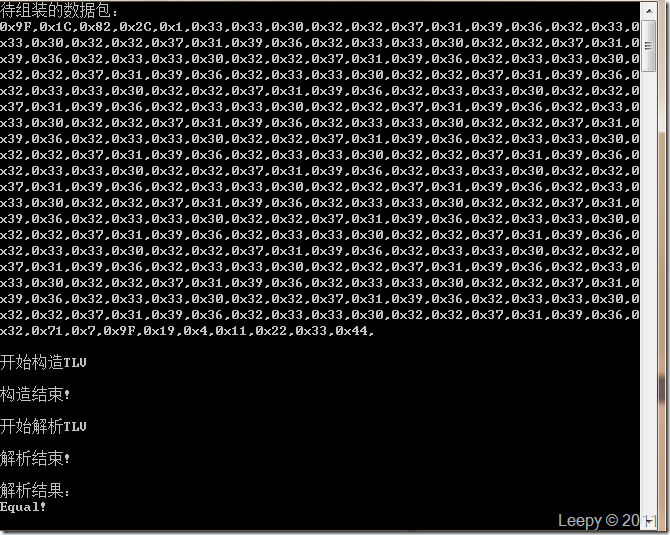TLV即Tag-Length-Value,常在IC卡与POS终端设备中通过这样的一个应用通信协议进行数据交换。在金融系统以及认证中,PBOC以及EMV的认证规范文档上面也有对TLV做了一些说明,由于认证规范都是英文文档,所以有些人可能不易于理解。首先我先介绍下什么是TLV,TLV的用途是什么,以及如何实现它的打包解包算法。
金融系统中的TLV是BER-TLV编码的一个特例编码规范,而BER-TLV是ISO定义中的规范。在TLV的定义中,可以知道它包括三个域,分别为:标签域(Tag),长度域(Length),内容域(Value)。这里的长度域的值实际上就是内容域的长度。
其实,在BER编码的方式有两种情况,一种是确定长度的方式,一种是不确定长度的方式,而金融TLV选择了确定长度的方式,这样在设备之间的数据传输量上就可以减少。
Tag域说明:
先来看下TLV的Tag是如何编码的,先看下图:

这张图说明了Tag域第一个字节的编码格式。其中b8-b1代表1个字节中的8个位。
其中b8,b7代表数据的类别。根据2个位的组合,有四种类别:通用类别,应用类别,上下文语境类别,专用类别。这个主要用于在于终端设备交互的时候,确定数据处理的类型。
b6代表的是数据元结构,也就是说它是属于简单数据元结构,还是属于结构(复合)数据元结构。当b6为1的时候,就需要后续的字节进行扩展。也就是说复合的TLV中,value域里也包含一个或多个TLV,这个稍后接着介绍。
当b5-b1代表串行号,当5个位都为1时,需要将tag域扩展到下一个字节中,也就是Tag占2个字节;而当5个位都不全为1时,该Tag域就只占1个字节。
现在,看下b5-b1:11111的情况:

从图中我们看到BER-TLV编码中,当b8为1时,Tag还需要有后续字节,直到b8为0为止。从EMV文档中的说明,Tag最多只占用2个字节,所以这样就相对比较简单一些了。当b8为0时,该Tag域结束,总共就占用2个字节。
Length域说明:
在文档中没有图片叙述,我自绘一个:

当b8为0时,该字节的b7-b1作为value域的长度;当b8为1时,b7-b1作为后续字节的长度,也就是说,例如有这样一个值:10000011,代表后续还有3个字节作为value域的长度(本字节不算,本字节变为作为一个Length的索引)。3个字节代表value的长度,意味着什么呢,意味着内容的长度当需要很大的时候,字节的位数就会跟着越高,3个字节就代表最大可以有256*256*256的长度。
Value域说明:
也是分成两种情况考虑,就是前面说到的Tag分成两个数据元结构,一种是简单数据元结构,一种是复合数据元架构:
先来看看简单数据元结构:

Tag就是Tag,没有子标签Tag,基本结构就是T-L-V。
再看下符合数据元结构:

后面的Value说明:Primitive or constructed BER-TLV data object number,包含一个简单数据元结构或者也可以是一个符合数据元结构。这样可以看出,算法中必须要实现Tag的嵌套功能,递归算法不可少。
算法实现:
根据以上的说明现在来实现它的打包解包的算法(打包的目的是将一个从终端上发的请求数据——字节数组,构造成一系列的TLV结构实体;解包的目的刚好相反,就是将TLV结构实体解析成字节数组,然后通过IC卡发送到终端上)。
首先定义一个TLV结构实体:
// TLV结构体
struct TLVEntity {unsigned char* Tag; //标记unsigned char* Length; //数据长度unsigned char* Value; //数据unsigned int TagSize; //标记占用字节数unsigned int LengthSize; //数据长度占用字节数TLVEntity* Sub_TLVEntity; //子嵌套TLV实体
};定义一个TLVPackage的打包类:
TLVPackage.h:
// TLV打包类
class TLVPackage
{
public:TLVPackage();virtual ~TLVPackage();//构造TLV实体static void Construct(unsigned char* buffer, unsigned int bufferLength, TLVEntity* tlvEntity, unsigned int& entityLength, unsigned int status=0);//解析TLV字节数组static void Parse(TLVEntity* tlvEntity, unsigned int entityLength, unsigned char* buffer, unsigned int& bufferLength);
};具体方法实现:
// 构造TLV
void TLVPackage:: Construct(unsigned char* buffer, unsigned int bufferLength, TLVEntity* tlvEntity, unsigned int& entityLength,unsigned int status)
{int currentTLVIndex = 0;int currentIndex = 0;int currentStatus = 'T'; //状态字符unsigned long valueSize = 0;while(currentIndex < bufferLength){switch(currentStatus){case 'T':valueSize = 0;//判断是否单一结构if((status == 1 && buffer[currentIndex] & 0x20) != 0x20){tlvEntity[currentTLVIndex].Sub_TLVEntity = NULL; //单一结构时将子Tag置空//判断是否多字节Tagif((buffer[currentIndex] & 0x1f) == 0x1f){int endTagIndex = currentIndex;while((buffer[++endTagIndex] & 0x80) == 0x80); //判断第二个字节的最高位是否为1int tagSize = endTagIndex - currentIndex + 1; //计算Tag包含多少字节tlvEntity[currentTLVIndex].Tag = new unsigned char[tagSize];memcpy(tlvEntity[currentTLVIndex].Tag, buffer + currentIndex, tagSize); tlvEntity[currentTLVIndex].Tag[tagSize] = 0;tlvEntity[currentTLVIndex].TagSize = tagSize;currentIndex += tagSize;}else{tlvEntity[currentTLVIndex].Tag = new unsigned char[1];memcpy(tlvEntity[currentTLVIndex].Tag, buffer + currentIndex, 1);tlvEntity[currentTLVIndex].Tag[1] = 0;tlvEntity[currentTLVIndex].TagSize = 1;currentIndex += 1;}}else{//判断是否多字节Tagif((buffer[currentIndex] & 0x1f) == 0x1f){int endTagIndex = currentIndex;while((buffer[++endTagIndex] & 0x80) == 0x80); //判断第二个字节的最高位是否为1int tagSize = endTagIndex - currentIndex + 1; //计算Tag包含多少字节tlvEntity[currentTLVIndex].Tag = new unsigned char[tagSize];memcpy(tlvEntity[currentTLVIndex].Tag, buffer + currentIndex, tagSize); tlvEntity[currentTLVIndex].Tag[tagSize] = 0;tlvEntity[currentTLVIndex].TagSize = tagSize;currentIndex += tagSize;}else{tlvEntity[currentTLVIndex].Tag = new unsigned char[1];memcpy(tlvEntity[currentTLVIndex].Tag, buffer + currentIndex, 1);tlvEntity[currentTLVIndex].Tag[1] = 0;tlvEntity[currentTLVIndex].TagSize = 1;currentIndex += 1; }//分析SubTagint subLength = 0; unsigned char* temp;if((buffer[currentIndex] & 0x80) == 0x80){for (int index = 0; index < 2; index++){subLength += buffer[currentIndex + 1 + index] << (index * 8); //计算Length域的长度}temp = new unsigned char[subLength];memcpy(temp, buffer + currentIndex + 3, subLength);}else{subLength = buffer[currentIndex];temp = new unsigned char[subLength];memcpy(temp, buffer + currentIndex + 1, subLength);}temp[subLength] = 0;//memcpy(temp, buffer + currentIndex + 1, subLength);unsigned int oLength;tlvEntity[currentTLVIndex].Sub_TLVEntity = new TLVEntity[1];Construct(temp, subLength, tlvEntity[currentTLVIndex].Sub_TLVEntity, oLength);}currentStatus = 'L';break;case 'L': //判断长度字节的最高位是否为1,如果为1,则该字节为长度扩展字节,由下一个字节开始决定长度if((buffer[currentIndex] & 0x80) != 0x80){tlvEntity[currentTLVIndex].Length = new unsigned char[1];memcpy(tlvEntity[currentTLVIndex].Length, buffer + currentIndex, 1);tlvEntity[currentTLVIndex].Length[1] = 0;tlvEntity[currentTLVIndex].LengthSize = 1;valueSize = tlvEntity[currentTLVIndex].Length[0];currentIndex += 1;}else{//为1的情况unsigned int lengthSize = buffer[currentIndex] & 0x7f;currentIndex += 1; //从下一个字节开始算Length域for (int index = 0; index < lengthSize; index++){valueSize += buffer[currentIndex + index] << (index * 8); //计算Length域的长度}tlvEntity[currentTLVIndex].Length = new unsigned char[lengthSize];memcpy(tlvEntity[currentTLVIndex].Length, buffer + currentIndex, lengthSize);tlvEntity[currentTLVIndex].Length[lengthSize] = 0;tlvEntity[currentTLVIndex].LengthSize = lengthSize;currentIndex += lengthSize;}currentStatus = 'V';break;case 'V':tlvEntity[currentTLVIndex].Value = new unsigned char[valueSize];memcpy(tlvEntity[currentTLVIndex].Value, buffer + currentIndex, valueSize);tlvEntity[currentTLVIndex].Value[valueSize] = 0;currentIndex += valueSize;//进入下一个TLV构造循环currentTLVIndex += 1;currentStatus = 'T';break;default:return;}}entityLength = currentTLVIndex;
}// 解析TLV
void TLVPackage::Parse(TLVEntity* tlvEntity, unsigned int entityLength, unsigned char* buffer, unsigned int& bufferLength)
{int currentIndex = 0;int currentTLVIndex = 0;unsigned long valueSize = 0;while(currentTLVIndex < entityLength){valueSize = 0;TLVEntity entity = tlvEntity[currentTLVIndex];memcpy(buffer + currentIndex, entity.Tag, entity.TagSize); //解析TagcurrentIndex += entity.TagSize;for (int index = 0; index < entity.LengthSize; index++){valueSize += entity.Length[index] << (index * 8); //计算Length域的长度}if(valueSize > 127){buffer[currentIndex] = 0x80 | entity.LengthSize;currentIndex += 1;}memcpy(buffer + currentIndex, entity.Length, entity.LengthSize); //解析LengthcurrentIndex += entity.LengthSize;//判断是否包含子嵌套TLVif(entity.Sub_TLVEntity == NULL){memcpy(buffer + currentIndex, entity.Value, valueSize); //解析ValuecurrentIndex += valueSize;}else{unsigned int oLength;Parse(entity.Sub_TLVEntity, 1, buffer + currentIndex, oLength); //解析子嵌套TLVcurrentIndex += oLength;}currentTLVIndex++;}buffer[currentIndex] = 0;bufferLength = currentIndex;
}然后写测试程序:
// 上发测试数据
unsigned char requestBuf[] = {0x9F, 0x1C, 0x12, 0x33, 0x33, 0x30, 0x32, 0x32, 0x37, 0x31, 0x39, 0x36, 0x32, 0x30, 0x34, 0x30, 0x34, 0x32, 0x37, 0x31, 0x38, 0x9F, 0x62, 0x01, 0x01, 0x57, 0x12, 0x62, 0x22, 0x89, 0x00, 0x00, 0x02, 0x91, 0x01, 0xD0, 0x90, 0x32, 0x01, 0x02, 0x47, 0x17, 0x13, 0x00, 0x0F, 0x5F, 0x20, 0x0A, 0x48, 0x55, 0x47, 0x55, 0x4F, 0x20, 0x4D, 0x49, 0x4E, 0x47, 0x9F, 0x1F, 0x3C, 0x25, 0x39, 0x39, 0x36, 0x32, 0x32, 0x32, 0x38, 0x39, 0x30, 0x30, 0x30, 0x30, 0x30, 0x32, 0x39, 0x31, 0x30, 0x31, 0x5E, 0x47, 0x55, 0x4F, 0x20, 0x4D, 0x49, 0x4E, 0x47, 0x2F, 0x48, 0x55, 0x5E, 0x30, 0x39, 0x30, 0x33, 0x32, 0x30, 0x31, 0x30, 0x32, 0x34, 0x37, 0x31, 0x30, 0x30, 0x30, 0x30, 0x30, 0x30, 0x30, 0x30, 0x30, 0x30, 0x32, 0x38, 0x39, 0x30, 0x30, 0x3F
}; TLVEntity tlvEntity[TLV_MAX_LENGTH];unsigned int tlv_count;//构造TLVTLVPackage::Construct(requestBuf, sizeof(requestBuf), tlvEntity, tlv_count);unsigned char parseBuf[1024];unsigned int buf_count;//解析TLVTLVPackage::Parse(tlvEntity, tlv_count, parseBuf, buf_count);if(strncmp((char*)parseBuf, (char*)requestBuf, sizeof(requestBuf)) == 0){AfxMessageBox("TRUE");}else{AfxMessageBox("FALSE");}最后测试结果中,可以得到最后将弹出“TRUE”的对话框。证明构造TLV得到的TLVEntity,再对这个实体进行解析,可以的到解析后的字节数组,最后通过strncmp的方法比较判断,是否原始字节数组和解析后的字节数组是否一致。
另外,为了方便C#程序员的使用,我对该C++程序重新改写了一下,得出的结果也是一样的。
TLVEntity.cs
/// /// TLV实体/// public class TLVEntity{/// /// 标记/// public byte[] Tag { get; set; }/// /// 数据长度/// public byte[] Length { get; set; }/// /// 数据/// public byte[] Value { get; set; }/// /// 标记占用字节数/// public int TagSize { get; set; }/// /// 数据长度占用字节数/// public int LengthSize { get; set; }/// /// 子嵌套TLV实体/// public TLVEntity Sub_TLVEntity { get; set; }}以及TLVPackage.cs
/// /// TLV打包类/// public class TLVPackage{/// /// 构造TLV/// /// public static List Construct(byte[] buffer){List list = new List();int currentTLVIndex = 0;int currentIndex = 0;int currentStatus = 'T'; //状态字符int valueSize = 0;TLVEntity tlvEntity = null;while (currentIndex < buffer.Length){switch (currentStatus){case 'T':tlvEntity = new TLVEntity();valueSize = 0;//判断是否单一结构if ((buffer[currentIndex] & 0x20) != 0x20){tlvEntity.Sub_TLVEntity = null; //单一结构时将子Tag置空【】//判断是否多字节Tagif ((buffer[currentIndex] & 0x1f) == 0x1f){int endTagIndex = currentIndex;while ((buffer[++endTagIndex] & 0x80) == 0x80) ; //判断第二个字节的最高位是否为1int tagSize = endTagIndex - currentIndex + 1; //计算Tag包含多少字节tlvEntity.Tag = new byte[tagSize];Array.Copy(buffer, currentIndex, tlvEntity.Tag, 0, tagSize);tlvEntity.TagSize = tagSize;currentIndex += tagSize;}else{tlvEntity.Tag = new byte[1];Array.Copy(buffer, currentIndex, tlvEntity.Tag, 0, 1);tlvEntity.TagSize = 1;currentIndex += 1;}}else{//判断是否多字节Tagif ((buffer[currentIndex] & 0x1f) == 0x1f){int endTagIndex = currentIndex;while ((buffer[++endTagIndex] & 0x80) == 0x80) ; //判断第二个字节的最高位是否为1int tagSize = endTagIndex - currentIndex + 1; //计算Tag包含多少字节tlvEntity.Tag = new byte[tagSize];Array.Copy(buffer, currentIndex, tlvEntity.Tag, 0, tagSize);tlvEntity.TagSize = tagSize;currentIndex += tagSize;}else{tlvEntity.Tag = new byte[1];Array.Copy(buffer, currentIndex, tlvEntity.Tag, 0, 1);tlvEntity.TagSize = 1;currentIndex += 1;}//分析SubTagint subLength = 0;byte[] temp;if ((buffer[currentIndex] & 0x80) == 0x80){for (int index = 0; index < 2; index++){subLength += buffer[currentIndex + 1 + index] << (index * 8); //计算Length域的长度}temp = new byte[subLength];Array.Copy(buffer, currentIndex + 3, temp, 0, subLength);}else{subLength = buffer[currentIndex];temp = new byte[subLength];Array.Copy(buffer, currentIndex + 1, temp, 0, subLength);}int oLength;tlvEntity.Sub_TLVEntity = new TLVEntity();List tempList = Construct(temp);tlvEntity.Sub_TLVEntity = tempList[0];}currentStatus = 'L';break;case 'L'://判断长度字节的最高位是否为1,如果为1,则该字节为长度扩展字节,由下一个字节开始决定长度if ((buffer[currentIndex] & 0x80) != 0x80){tlvEntity.Length = new byte[1];Array.Copy(buffer, currentIndex, tlvEntity.Length, 0, 1);tlvEntity.LengthSize = 1;valueSize = tlvEntity.Length[0];currentIndex += 1;}else{//为1的情况int lengthSize = buffer[currentIndex] & 0x7f;currentIndex += 1; //从下一个字节开始算Length域for (int index = 0; index < lengthSize; index++){valueSize += buffer[currentIndex + index] << (index * 8); //计算Length域的长度}tlvEntity.Length = new byte[lengthSize];Array.Copy(buffer, currentIndex, tlvEntity.Length, 0, lengthSize);tlvEntity.LengthSize = lengthSize;currentIndex += lengthSize;}currentStatus = 'V';break;case 'V':tlvEntity.Value = new byte[valueSize];Array.Copy(buffer, currentIndex, tlvEntity.Value, 0, valueSize);currentIndex += valueSize;//进入下一个TLV构造循环list.Add(tlvEntity);currentStatus = 'T';break;default:return new List();}}return list;}/// /// 解析TLV/// /// /// public static byte[] Parse(List list){byte[] buffer = new byte[4096];int currentIndex = 0;int currentTLVIndex = 0;int valueSize = 0;while (currentTLVIndex < list.Count()){valueSize = 0;TLVEntity entity = list[currentTLVIndex];Array.Copy(entity.Tag, 0, buffer, currentIndex, entity.TagSize); //解析TagcurrentIndex += entity.TagSize;for (int index = 0; index < entity.LengthSize; index++){valueSize += entity.Length[index] << (index * 8); //计算Length域的长度}if (valueSize > 127){buffer[currentIndex] = Convert.ToByte(0x80 | entity.LengthSize);currentIndex += 1;}Array.Copy(entity.Length, 0, buffer, currentIndex, entity.LengthSize); //解析LengthcurrentIndex += entity.LengthSize;//判断是否包含子嵌套TLVif (entity.Sub_TLVEntity == null){Array.Copy(entity.Value, 0, buffer, currentIndex, valueSize); //解析ValuecurrentIndex += valueSize;}else{byte[] tempBuffer = Parse(new List { entity.Sub_TLVEntity });Array.Copy(tempBuffer, 0, buffer, currentIndex, tempBuffer.Length); //解析子嵌套TLVcurrentIndex += tempBuffer.Length;}currentTLVIndex++;}byte[] resultBuffer = new byte[currentIndex];Array.Copy(buffer, 0, resultBuffer, 0, currentIndex);return resultBuffer;}}接着,写测试程序:
static byte[] requestBuffer = {0x9F, 0x1C, 0x82, 0x2C, 0x01,0x33, 0x33, 0x30, 0x32, 0x32, 0x37, 0x31, 0x39, 0x36, 0x32,0x33, 0x33, 0x30, 0x32, 0x32, 0x37, 0x31, 0x39, 0x36, 0x32,0x33, 0x33, 0x30, 0x32, 0x32, 0x37, 0x31, 0x39, 0x36, 0x32,0x33, 0x33, 0x30, 0x32, 0x32, 0x37, 0x31, 0x39, 0x36, 0x32,0x33, 0x33, 0x30, 0x32, 0x32, 0x37, 0x31, 0x39, 0x36, 0x32,0x33, 0x33, 0x30, 0x32, 0x32, 0x37, 0x31, 0x39, 0x36, 0x32,0x33, 0x33, 0x30, 0x32, 0x32, 0x37, 0x31, 0x39, 0x36, 0x32,0x33, 0x33, 0x30, 0x32, 0x32, 0x37, 0x31, 0x39, 0x36, 0x32,0x33, 0x33, 0x30, 0x32, 0x32, 0x37, 0x31, 0x39, 0x36, 0x32,0x33, 0x33, 0x30, 0x32, 0x32, 0x37, 0x31, 0x39, 0x36, 0x32,0x33, 0x33, 0x30, 0x32, 0x32, 0x37, 0x31, 0x39, 0x36, 0x32,0x33, 0x33, 0x30, 0x32, 0x32, 0x37, 0x31, 0x39, 0x36, 0x32,0x33, 0x33, 0x30, 0x32, 0x32, 0x37, 0x31, 0x39, 0x36, 0x32,0x33, 0x33, 0x30, 0x32, 0x32, 0x37, 0x31, 0x39, 0x36, 0x32,0x33, 0x33, 0x30, 0x32, 0x32, 0x37, 0x31, 0x39, 0x36, 0x32,0x33, 0x33, 0x30, 0x32, 0x32, 0x37, 0x31, 0x39, 0x36, 0x32,0x33, 0x33, 0x30, 0x32, 0x32, 0x37, 0x31, 0x39, 0x36, 0x32,0x33, 0x33, 0x30, 0x32, 0x32, 0x37, 0x31, 0x39, 0x36, 0x32,0x33, 0x33, 0x30, 0x32, 0x32, 0x37, 0x31, 0x39, 0x36, 0x32,0x33, 0x33, 0x30, 0x32, 0x32, 0x37, 0x31, 0x39, 0x36, 0x32,0x33, 0x33, 0x30, 0x32, 0x32, 0x37, 0x31, 0x39, 0x36, 0x32,0x33, 0x33, 0x30, 0x32, 0x32, 0x37, 0x31, 0x39, 0x36, 0x32,0x33, 0x33, 0x30, 0x32, 0x32, 0x37, 0x31, 0x39, 0x36, 0x32,0x33, 0x33, 0x30, 0x32, 0x32, 0x37, 0x31, 0x39, 0x36, 0x32,0x33, 0x33, 0x30, 0x32, 0x32, 0x37, 0x31, 0x39, 0x36, 0x32,0x33, 0x33, 0x30, 0x32, 0x32, 0x37, 0x31, 0x39, 0x36, 0x32,0x33, 0x33, 0x30, 0x32, 0x32, 0x37, 0x31, 0x39, 0x36, 0x32,0x33, 0x33, 0x30, 0x32, 0x32, 0x37, 0x31, 0x39, 0x36, 0x32,0x33, 0x33, 0x30, 0x32, 0x32, 0x37, 0x31, 0x39, 0x36, 0x32,0x33, 0x33, 0x30, 0x32, 0x32, 0x37, 0x31, 0x39, 0x36, 0x32,0x71, 0x07, 0x9f, 0x19, 0x04, 0x11, 0x22, 0x33, 0x44};static void Main(string[] args){Console.WriteLine("待组装的数据包:");requestBuffer.ToList().ForEach(o => { Console.Write("{0},", "0x" + o.ToString("X")); });Console.WriteLine("\r\n\r\n开始构造TLV");//构造TLVList list = TLVPackage.Construct(requestBuffer);Console.WriteLine("\r\n构造结束!");Console.WriteLine("\r\n开始解析TLV");//解析TLVbyte[] responseBuffer = TLVPackage.Parse(list);Console.WriteLine("\r\n解析结束!");Console.WriteLine("\r\n解析结果:");if (ByteEquals(requestBuffer, responseBuffer)){Console.WriteLine("Equal!");}else{Console.WriteLine("Not Equal!");}Console.ReadKey();}运行结果:

总结
TLV在数据通信方面,其实运用得很广泛,在应用层数据通信中,如HTTP协议,HTML,XML语言本身定义了一些标签(Body,Head,Script)对数据串行化,接收方再根据标签解析原始数据,通过浏览器展现出来。因此本质上也是属于TLV协议的设计模式。甚至在传输层的TCP,UDP协议,你完全可以通过TLV实现自定义的应用协议。
附上C#源代码:TLVPackageDemo.rar
